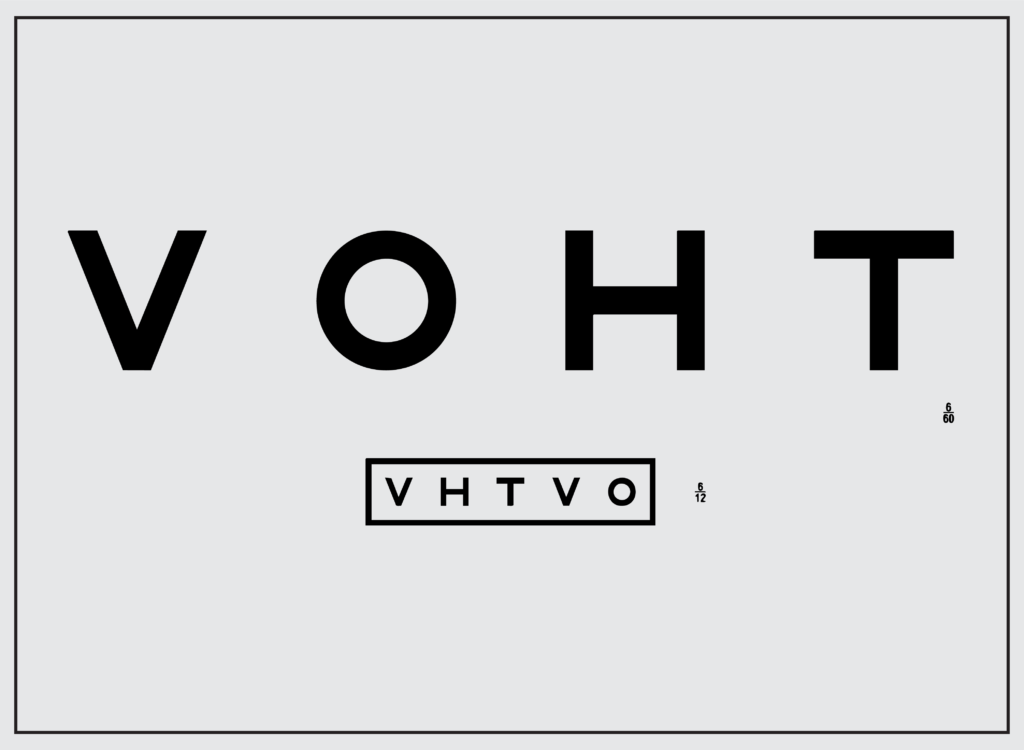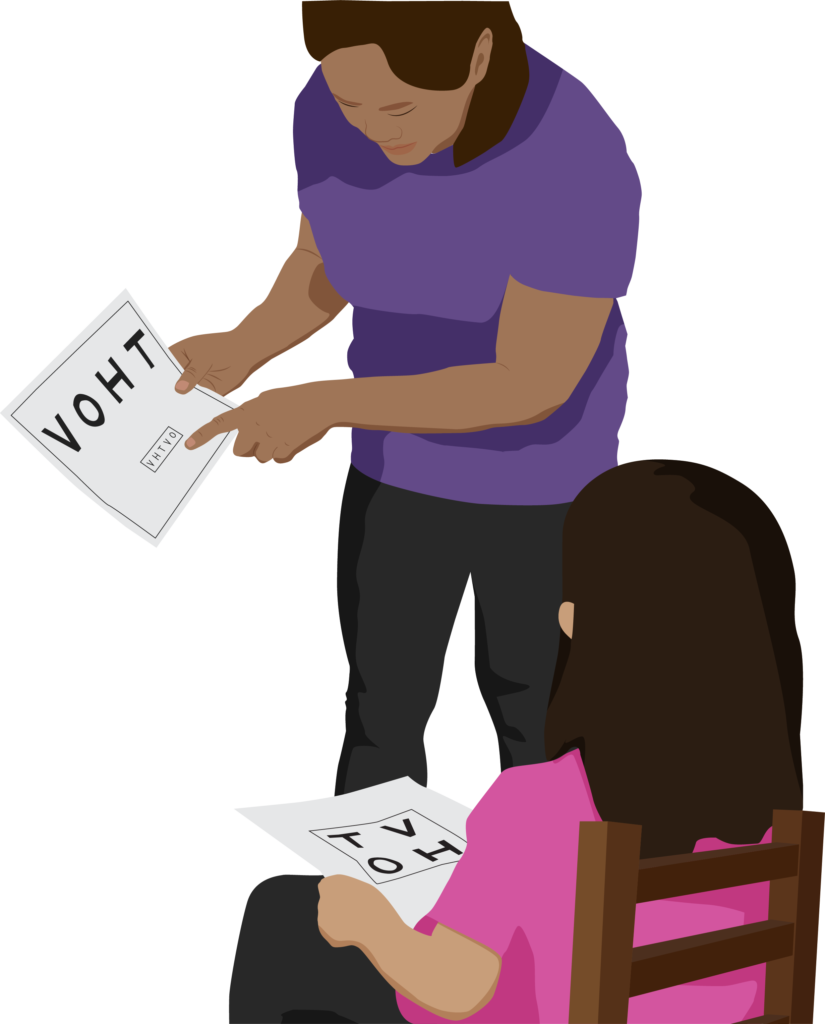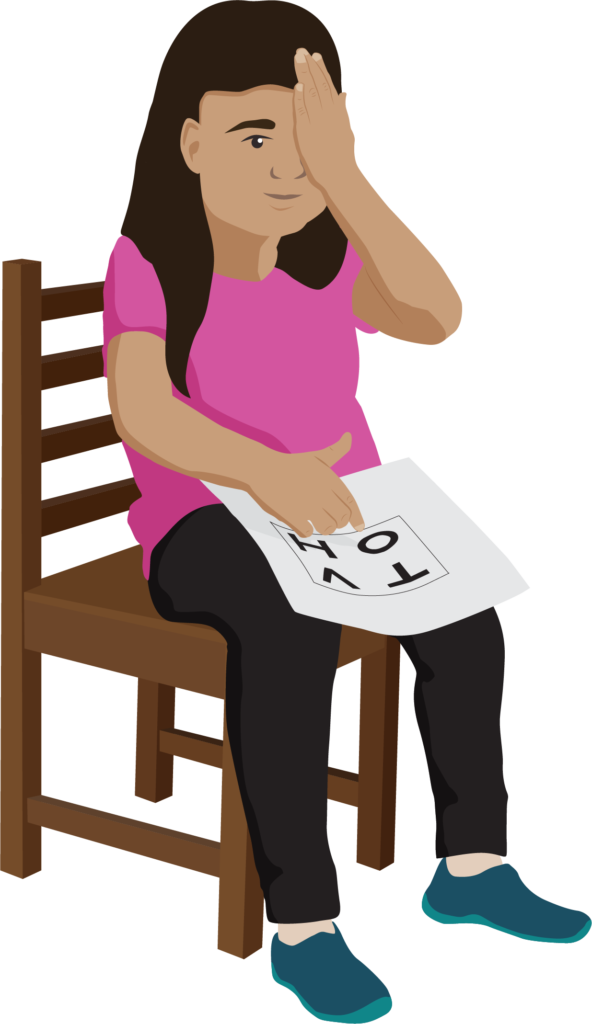Distance vision screen for children aged 8 years and younger
Instruction
In this topic you will learn how to carry out a distance vision screen for children aged 8 years and younger, using an HOTV chart.
Distance vision screen

Chart
There are two rows of letters:
- One large row of the letters VOHT (6/60)
- One small row of the letters VHTVO (6/12).
The numbers next to each row of letters describe the size of the letters.
Instruction
For children 8 years and younger select the HOTV chart on the form.

Explain the vision screen using the HOTV chart:
- Give the child the card they will point to (pointing card)
- Instruct the child to hold the pointing card flat on their lap, with the letters facing them.
Explain that they will need to match the letter they see on the chart, to the pointing card on their lap.
Check the child has understood:
- Point to a letter on the top line (6/60) of the chart
- Ask the child to match the letter on their pointing card.
Tip
If needed, a helper can assist by sitting or standing next to the child and holding the pointing card.
This is particularly helpful for younger children or those with a learning disability.
If a child is unable to understand or carry out the instructions, do not continue with the vision screen. Select Refer Continue directly to the eye health screen.
Spectacles
Instruction
If the child wears spectacles for distance vision, check if they are wearing them today.
If the child needs to wear their spectacles for the vision screen:
- Check the spectacles are clean
- Record that spectacles are being worn on the Screen form.
If you are using an occluder, clean it before using.

Right eye
Instruction
Start with the child’s right eye.

- Ask the child to cover their left eye with an occluder (or palm of their left hand), leaving the right eye open to see
- Make sure that the child does not press the occluder (or hand) onto their eye
- Check the child is covering their eye properly. If the child has difficulty covering their eye, a helper can assist.
Right eye: top line
Using a pen or finger, point to each letter on the top line (6/60) and ask the child to point to the matching letter on the HOTV pointing card.
Tip
- Move your hand steadily, pointing under each letter
- Avoid covering or hiding the letter with your hand or arm.

- If child matches 2 or more letters correctly on the top line record Yes Continue to the bottom line
- If child matches fewer than 2 letters record No Complete result and continue to left eye.
Right eye: bottom line
Point to each letter on the bottom line (6/12) and ask the child to point to the matching letter on the HOTV pointing card.
- If child matches 3 or more letters correctly on the bottom line record Yes
- If child matches fewer than 3 letters record No.
Right eye: result
- If Yes to both (top and bottom line), this is a pass result
- If a No result to any (top or bottom line), this is a Refer result.
Left eye
Instruction
Repeat distance vision screen for child’s left eye.
Ask the child to cover their right eye with an occluder (or palm of their right hand), leaving the left eye open to see.

Left eye: top line
- If child matches 2 or more letters correctly on the top line (6/60) record Yes Continue to the bottom line
- If child matches fewer than 2 letters record No Complete result and continue to eye health screen.
Left eye: bottom line
- If child matches 3 or more letters correctly on the bottom line (6/12) record Yes
- If child matches fewer than 3 letters record No.
Left eye: result
- If Yes to both (top and bottom line), this is a pass result
- If a No result to any (top or bottom line), this is a Refer result.
Question

Meet Patryk
Patryk is six years old. He participated in his school’s sensory screening programme. Read his Screen form and answer the questions.

1. What result will you record for his right eye?
Pass is correct!
Patryk had Yes for both the top and bottom line with his right eye. This is a pass result.
2. What result will you record for his left eye?
Refer is correct!
Patryk had a Yes for the top line and a No for the bottom line. If No to any, this is a Refer result.
Instruction
Watch this video of a health worker carrying out a Distance vision screen for a child 8 years and younger.
Activity
In groups:
- Explain the distance vision screen using HOTV chart and pointing card and practice to check they understand
- Complete the test
- Record the result on the Screen form.
Take turns to be screener and person being screened.

